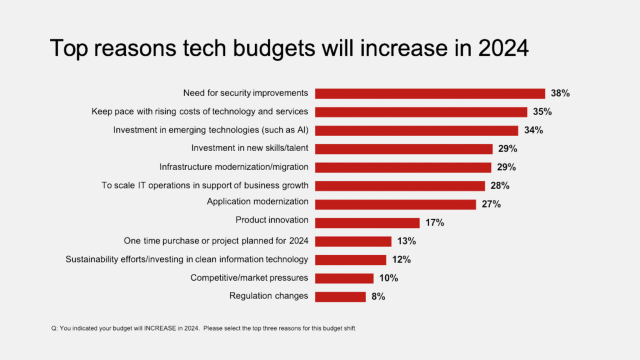Since the dawn of digital transformation, the CIO’s role is nearly fluid with the level of adaptation it’s made. In fact, 87% of CIOs are more involved in leading digital transformation initiatives compared to their business counterparts. So, what should CIOs expect this year? And what are the boots-on-the-ground CIOs reporting back?
At Foundry’s Inspire to Connect event, CIO.com’s editorial team drew from their vast industry knowledge, constant dialogue with CIOs and recent industry studies to provide valuable insights into the ever-evolving landscape of digital transformation. Speakers included myself, CIO, Ken Mingis, Executive Editor, Computerworld US, Amy Bennett, Editor in Chief, CIO, Computerworld, CSO, InfoWorld, and Network World and Ann Bednarz, Executive Editor, Network World.
“IT leaders want to make sure they’re on top of what’s happening in the technology world, figuring out how to get the right information to make the best decisions for the next five years.”
Ken Mingus, Executive Editor, Computerworld, US.
Here, we dive into the insights from CIOs on topics crucial for understanding today’s technology buyers and navigating a dynamically changing tech landscape:
What are the everyday challenges or pain points that we might not be aware of in their roles as technology leaders?
Faced with everyday challenges such as security threats, economic uncertainty, and operationalizing AI, as well as a rapidly evolving landscape to navigate, the job of a CIO is no easy task. According to Foundry’s 2024 State of the CIO research, 85% of CIOs agree that the CIO is becoming a change maker, increasingly leading business and technology initiatives. Additionally, 80% of CIOs agree they’re tasked with researching and evaluating possible AI additions to their tech stack.
CIOs everyday challenges and pain points:
- CIOs are addressing issues such as constantly evolving threats, the specter of ransomware attacks, and the heightened attention from board-level stakeholders.
- Faced with the technology skills gap and the erosion of traditional career paths, CIOs are challenged with building and retaining a skilled workforce.
- In the realm of innovation, CIOs are pushing for digital and innovation agendas, all while facing hurdles associated with the implementation of generative AI.
- Remaining current on happenings in the technology world is a top priority for CIOs, ensuring that they are well-informed and adaptable.
- Budget alignment is a persistent challenge for CIOs who must find a balance between allocating resources to maintain existing systems and investing funds for new innovations.
What are IT leaders and tech buyers reading, and how do they consume that information?
Tech buyers use a diverse range of sources to gather information on technology innovation trends and vendor options. However, 87% of IT buyers say it’s challenging to find high-quality content. The challenge lies in filtering through the abundance of information, emphasizing the need for curated, reliable sources. So, where are tech buyers turning to find their high-quality content?
Types of content and information that tech buyers are consuming:
- Tech buyers continue to rely on traditional sources such as industry conferences, publications, and established vendor relationships, recognizing their enduring importance despite the evolving landscape.
- Online resources such as tech websites, blogs, and social media platforms play a significant and dynamic role in keeping IT decision-makers updated on the latest developments in technology.
- Peer networks and professional associations contribute significantly to knowledge-sharing and provide opportunities for learning from industry peers, enhancing understanding of market dynamics.
What are the most important pieces of data that IT leaders rely on while making a cybersecurity investment decision?
Faced with the pressure of demonstrating return on investment (ROI), IT leaders prioritize this key aspect when making investment decisions. Here are a few important KPIs and areas of information that IT leaders rely on when making cybersecurity investment decisions:
- IT leaders prioritize ROI over price.
- Their main focus is on achieving tangible returns with a clear timetable.
- There is significant pressure on demonstrating ROI in IT product purchases. Vendors are expected to acknowledge and address the pressures involved in these decisions.
“IT leaders are seeking successful purchases and a clear return on investment, with a growing emphasis on the need for meaningful customer connections and insights from real-world implementations.”
Amy Bennett, Global Editor-in-Chief for CIO.com.
Along with important pieces of data, the top tech initiatives driving investment are security risk management (45%), machine learning/artificial intelligence (AI) (44%), and business process automation/IT automation (44%). These initiatives represent a proactive response to the challenges and opportunities presented by the digital era.

How do you undertake the buying process? The stages, the resources, and the teams involved?
CIOs play an important role in the buying process and in deciding on strategic investments for the organization. Working closely with other stakeholders, 79% of CIOs have a strong educational partnership with the CEO/board of directors. In 2024, there will be increased emphasis on working more often with line of business executives during specific stages of the technology purchase process such as determining business needs and evaluating products and services.

The stages, resources, and teams involved in the tech buying process:
- Stability and reliability in vendors are crucial, aligning with the long-term plans of organizations to ensure sustained effectiveness and support.
- Operating in a global market, it becomes increasingly important for IT leaders to stay informed about global events as technology decisions have widespread impacts. Awareness of the global context is key to making informed and strategic choices.
- Recognizing the trend of increased collaboration and shared processes between network and security teams, IT leaders are navigating a complex decision-making landscape. With an average buying team size of 25 people and months of research, decision-making involves thorough consideration.
- IT leaders prioritize making sure new products work well with their current systems. They want to avoid buying something that ends up unused with features they don’t need. Understanding how a product integrates and its practical use is crucial for them.
Challenges of messaging to the data audience while driving a business outcome viewpoint.
When it comes to reaching B2B and IT audiences, crafting compelling messaging is vital to business success. To properly tailor your messaging, this involves understanding the unique challenges and priorities of your audiences.
Approaches used by CIOs in crafting messages to reach and connect with a data audience:
- Prioritize understanding customer challenges rather than promoting a specific viewpoint in pitches.
- Emphasize the importance of establishing a genuine customer connection in pitches.
- Look for pitches that provide a realistic view, including both success stories and challenges faced by customers.
- Actively seek customer connections and stories that offer valuable lessons to readers.
- Recognize the value of connecting with companies that have deployed the technology, and sharing practical experiences.
“It’s crucial to shift the focus from driving a specific viewpoint to addressing the challenges of customers, ensuring that the narrative resonates with their real-world struggles and aligns with the ultimate goal of driving meaningful business outcomes.”
Amy Bennett, Global Editor-in-Chief for CIO.com
What trends will we see in technology leadership and tech buying in 2024?
As budgets rise and the digital landscape continues to evolve, this year will be shaped by notable trends in technology leadership and tech buying. Security, rising costs, and investments in AI dominate the top three reasons budgets will increase in 2024. These trends highlight how important it will be for tech leaders to encourage growth and innovation.

Trends CIOs identified in tech buying for 2024:
- Generative AI (Gen AI) takes the spotlight in 2024, introducing challenges associated with its adoption.
- Tech companies are focusing on upskilling workers and making strategic investments in the existing workforce.
- Amidst transformative shifts in the job market, a key focus emerges on skills development.
- There will be a significant emphasis on sustainability-driven purchases reflected in the IT landscape.
- Growing interest is observed in energy-efficient servers, and sustainability metrics are becoming integral to decision-making processes in the industry.
Conclusion
CIOs are positioned to play a crucial role in driving growth and innovation amidst transformative changes in the digital era. In 2024, the CIO will face numerous challenges, including those around increasing security threats and AI adoption. Despite these, the role of the CIO is stronger than ever as their visibility within the business continues to elevate and technology budget growth is positive.
Want deeper insights into the evolving role of the CIO? Download Foundry’s latest research, State of the CIO 2024.



